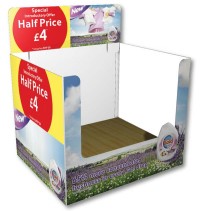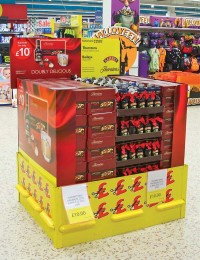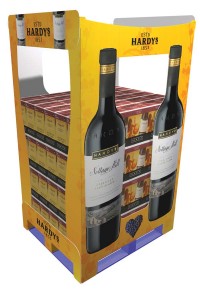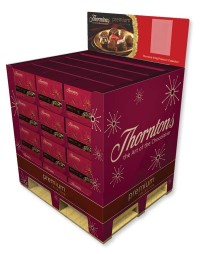 With over two thirds of all final consumer purchase decisions made at the point of sale, getting your display right is critical to increasing sales. A major growth area for CRP, one of Europe’s leading independent decorative print and packaging groups, is its Display business, who creates award winning point of sale display units, for many of Europe’s leading brands and retailers. CRP’s dedicated creative and structural design team produce visually striking display units that help their customers to stand out and differentiate their brand from others within the market.
With over two thirds of all final consumer purchase decisions made at the point of sale, getting your display right is critical to increasing sales. A major growth area for CRP, one of Europe’s leading independent decorative print and packaging groups, is its Display business, who creates award winning point of sale display units, for many of Europe’s leading brands and retailers. CRP’s dedicated creative and structural design team produce visually striking display units that help their customers to stand out and differentiate their brand from others within the market.
CRP has significant market position within each of its product groups, Display, Litho Packaging, Pre-Print & Coatings, Heavy Duty Packaging, Direct Food Contact Packaging and Digital Print. CRP is a major player and manufacturer within the decorative product market and a leader in print, design and innovation. With emphasis on state-of-the-art design throughout the business, backed by exceptional customer service, CRP has a unique offer that differentiates them from others within the sector; their speed and print capability is quite exceptional. Mike Devine, Display Sales Manager at CRP, spoke to The Grocery Trader.
The Grocery Trader – Mike, what does your role involve? Are you personally involved in developing solutions for clients?
As Sales Manager for our Display Business, I lead our activities in this area with my sales colleagues, our award winning design team and project management teams, continuously managing projects through the supply chain and into retailers.
GT – How much of your business specifically involves in-store display units?
At CRP we are fortunate to deal with a broad spectrum of high profile brand owners and retailers across a number of market sectors. Display pallets are only one of a number of our product specialities and represent a growing segment within the POS market. This is largely driven by retailers seeking uniformity and a low cost solution to delivering volume pre-filled product as easily as possible through the supply chain in to store.
GT – How are you set up to service the needs of brand owners and retailers?
We have an extensive network and knowledge of retailers, and have approved and preferred supplier status with a number of these. This requires us to balance the relationship between brand owners and retailers.
GT – This interview is all about in-store display units, but first, a few questions about CRP as a whole. When was CRP founded? Who owns CRP, and do you operate in any other countries besides the UK?
 CRP has a long history of supplying in store POS units, and was an early entrant into the market more than twenty years ago. CRP is a unique independent decorative products group, owned by a working board of directors and strong senior management team. This creates a highly motivated group who are passionate about their products and services. Though based wholly in the UK, we have an extensive knowledge of European retailers and deliver display units on a pan-European basis. The company has a long history of winning European POPAI awards and recently was fortunate to have won a silver award in the temporary food category.
CRP has a long history of supplying in store POS units, and was an early entrant into the market more than twenty years ago. CRP is a unique independent decorative products group, owned by a working board of directors and strong senior management team. This creates a highly motivated group who are passionate about their products and services. Though based wholly in the UK, we have an extensive knowledge of European retailers and deliver display units on a pan-European basis. The company has a long history of winning European POPAI awards and recently was fortunate to have won a silver award in the temporary food category.
GT – You started making in-store display units in the early 1990s. Do you have a record of who the earliest customers were, and what you did for them?
Our earliest clients included Nestlé and Diageo. We were fortunate to work with these prestigious brands early on, producing pallet displays and imaginatively designed floor stands.
GT – How big a business now are in-store display units in the UK?
It’s a growing market, with retailers driving the move to using these units.
GT – How big a part of CRP’s business are they now?
As specialists in temporary display units, we don’t differentiate between floor stands and end aisle display units for major retailers. We are seeing an increase in the use of this type of unit in the grocery sector. We are also seeing growth in seasonal activities such as Easter and Christmas.
GT – How does the UK compare with the rest of the world in its deployment of in-store display pallets?
We have seen considerable growth in the use of in-store pallets here in the UK market. European retailers were much quicker to embrace the idea of placing pallets directly into the in-store environment. European retailers have a more relaxed approach and are happy to see pallets directly on the shop floor.
GT – Whereabouts in store can you use display pallets to best effects? What size area do you need?
Siting of pallet display units varies by retailer. The sizes of units differ from quarter pallet to full pallet, and they can be situated anywhere in store where there is high footfall.
GT – What’s your USP as an ISDP provider? Why come to CRP for an in-store display pallet solution?
 Many POS providers can produce pallet displays, and to some degree this has been commoditised in recent years. The approach within our business is to focus not only on delivering cost effective units, but also to focus on maintaining brand equity with in-house litho graphics. We are able to utilise packaging-based manufacturing techniques and technology to produce display units cost effectively. We have worked with a number of brands to develop innovative design solutions that deliver not only cost savings in co-packing, but also considerable savings through the supply chain.
Many POS providers can produce pallet displays, and to some degree this has been commoditised in recent years. The approach within our business is to focus not only on delivering cost effective units, but also to focus on maintaining brand equity with in-house litho graphics. We are able to utilise packaging-based manufacturing techniques and technology to produce display units cost effectively. We have worked with a number of brands to develop innovative design solutions that deliver not only cost savings in co-packing, but also considerable savings through the supply chain.
GT – For the uninitiated, what different basic types of in-store display units are available, and what kinds of products would you use them for?
Our display units aren’t standard offers: each time a client presents us with a request it is unique, be it a floor stand or a pallet unit. The chassis is one of a number of specific options, but the solution is always different and unique to the brand.
GT – What different chassis units do you work with?
The chassis is defined by the footprint needed: it could be a standard pallet, a half pallet or Euro pallet, a plastic pallet, a dolly unit or a Quickbox, otherwise known as a hod.
GT – In non-technical terms, is it a matter of simply making a carton, sourcing a pallet and gluing the two together?!
It comes down to how the product is to be merchandised, and the amount of products going on display. A single product is relatively simple, but when different products need to be merchandised separately in the unit, the design solution is driven by the type of product involved and how it fits into store environment.
GT – What different kinds of pallet are suitable for use as in-store display pallets – cardboard, plastic? Do you make your own pallets?
We rent the plastic pallets from predefined specialists, as stipulated by the retailer. The co-packer rents these for the length of the promotion. However, we do manufacture timber and wooden pallets in-house, in our heavy duty corrugated business that enables us to provide a further solution in-house that is unique to CRP.
GT – Where do you design and produce your ISDPs?
All our structural and graphic design is housed at CRP’s facilities in Corby, Northamptonshire. Our design and graphics team won design team of the year at the UK Packaging Awards 2010. This reinforces the company’s ability to produce imaginatively designed display and packaging solutions that are without doubt best in class.
GT – What are the steps involved in designing an ISDP solution for a client?
From customer brief we reach an understanding of the specific needs and requirements of both the brand owner and retailer. Designers work around stock load-ups and how the product is displayed. The prototype design is sampled and tested and then goes to the retailer for approval. We carry out major testing internally including weight testing and transit testing, all at our design facility in Corby.
GT – In principle, how easy is it to achieve both strong visual in-store impact and structural support?
 In terms of structural support, there can be no compromise, but the unit must also perform in terms of promoting the stock it holds. We work with brand owners and retailers to achieve instant brand recognition whilst ensuring the retailer retains in store conformity.
In terms of structural support, there can be no compromise, but the unit must also perform in terms of promoting the stock it holds. We work with brand owners and retailers to achieve instant brand recognition whilst ensuring the retailer retains in store conformity.
GT – What is the minimum order quantity for a display pallet?
We manufacture anything from 50 units to 5,000 plus and have a cost-effective in-house print solution for high and low volume requirements. Our specialisation is that we are one of the only UK manufacturers with in-house litho printing. Other manufacturers choose to use older solutions. When brand equity is a priority with a number of copycat brands in the market, only litho print can provide the brand owner the assurance of achieving complete brand recognition.
GT – At what stage do you, CRP, get involved in the planning for promotions which use your packaging solutions? How far ahead do you work? Can you turn around last-minute solutions?
Typically we have fairly short lead times, which we negotiate with retailers. We can turn projects round in two or three weeks from conception. We’re in a fortunate position to have regular volume work from various brand owners, but we’re often also called on to come up with solutions at short notice. The culture within our business is very focused on customers: if there’s a way to do it, we’ll find it! We are able to provide a complete design solution and high quality colour mock ups via our design process.
Our project managers arrive at solutions very quickly, and we can provide a complete solution to the client within five days.
GT – Are there peak times of year for in-store display units?
The in store display market is focused around promotional activity and accordingly demand does fluctuate, with activities for Easter and Christmas and other promotional activities such as the World Cup and the forthcoming Olympics.
GT – Can these units be easily refilled and restocked with product while on the stop floor?
 Retailers want display units delivered pre-filled and ready to merchandise: it’s unlikely that they will re-fill them, but will replace them. This puts the emphasis on us as the supplier to design units that can be instantly placed in-store.
Retailers want display units delivered pre-filled and ready to merchandise: it’s unlikely that they will re-fill them, but will replace them. This puts the emphasis on us as the supplier to design units that can be instantly placed in-store.
GT – Do you work direct with clients, or with their design agencies, or both?
We tend to work exclusively with the brand owners, and have little involvement with design agencies.
GT – You did some work last year for Thornton’s and Baileys on a joint promotion. How did that come about? To what extent was the retailer involved?
Thornton’s and Baileys respective brand owners developed the concept together and then came to CRP to develop the display units. The retailer agreed our initial concept principles and we then went on to design and weight test the unit as it was holding both lightweight chocolate boxes and heavy weight glass bottles.
GT – What sets you apart from other print and packaging manufacturers in this area?
We have a considerable history of developing award winning display and packaging solutions. We are constantly looking at alternative manufacturing technology to enable us to drive the costs of manufacturing displays down. Our in-house project management team oversee the development of each unit from start to finish. I am proud to lead a team of dedicated and highly capable professionals, who continually delight our customers with polished in-store display solutions.
GT – What industry quality standards do you work to?
CRP has ISO, FSC and PEFC accreditations. We are able to produce display units and shelf ready packaging that offer our customers visibility of the Chain of Custody. We hope in achieving these accreditations that we can do our part in helping brand owners work towards achieving their environmental objectives.
GT – What does ‘chain of custody’ mean, in non-technical terms?
Chain of custody accreditation means that we have complete visibility of the source of our materials, and are able to offer our customers traceability to demonstrate that raw materials are from sustainable sources.
GT – What difference does Chain of Custody make?
It gives reassurance to retailers and brand owners that as a company our products satisfy the highest industry standards.
GT – How ‘green’ are your in-store display pallets? Are they biodegradable?
All our temporary displays can be made from fully sustainable and recyclable materials, of which is the majority are biodegradable as they are paper.
GT – Have you won any awards for your in-store display pallets?
We have a long history of creating award-winning POS units. This year, for the third year running, we have received accolades and awards on a pan–European basis from POPAI Europe. Within the UK POPAI awards, our credentials are even stronger, with a long history of gold awards for many of the UKs leading brands. In-store pallet displays are about functionality and the retailers’ drive for efficiencies. However, we take the same care and attention to provide well-designed and visually striking display units.
GT – What are the trends in the deployment of in-store display units?
The market is well established and very much focused around retailer requirement: we have seen a substantial shift towards the pre-filled format. This of course cuts down costs for the retailer in not having to re-fill units.
GT – Where do you see in-store display units going from here as elements in the marketing mix?
 Space within retail is of course always at a premium. They are selling more value-added products, so any off-shelf siting they can achieve is a major benefit. The role of POS units in supermarkets is very strong, and will continue to be so for the foreseeable future.
Space within retail is of course always at a premium. They are selling more value-added products, so any off-shelf siting they can achieve is a major benefit. The role of POS units in supermarkets is very strong, and will continue to be so for the foreseeable future.
GT – Finally, where do you see CRP’s in-store display pallet business going?
We have very experienced, highly skilled project management and design teams within our display business. Our leading position within the temporary display market means that we are the preferred choice for many brands. Our ability to provide in-house high quality litho printing linked with manufacturing display components within our packing factories makes our offer truly unique.
CRP
Tel: 01536 200 333




Comments are closed.